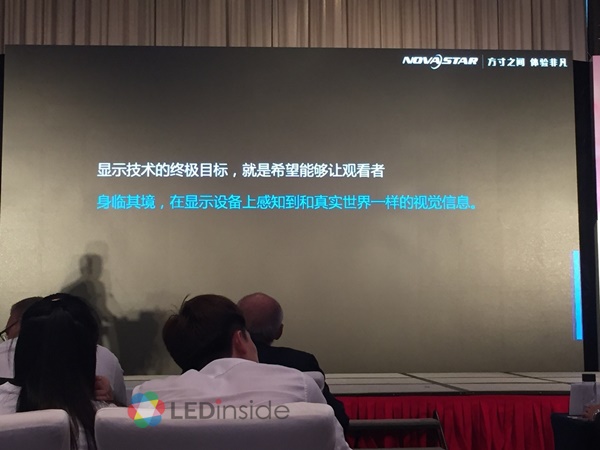Organized at the Langham, Shenzhen, on 19th July, Macroblock LED Display Conference 2017, gathering makers of displays and LED light sources worldwide, ended on a high note as it always did for the past 12 years. At this high-profile annual event, Macroblock’s chairman Dr. Li Chang Yang stated that display technology has been more widely used for various applications in different ways, such as displays in retail spaces, theaters, restaurants with immersive AR technology, and interactive applications.
The mainstream fine pitch display pretty much fall into the range from P1.25 in 2017. As the pitch size gets finer, the mainstream in 2018 and 2019 may downsize to below P1.0. Micro LED will also enter the market around the same time. Faced with the shift, Macroblock has already prepared itself for the market of P1.0 ultra-fine pitch display by offering corresponding advanced solutions to its clients.
 |
|
(Image: LEDinside) |
Byron Liang, Marketing Manager at Osram Opto Semiconductors (China), addressed four challenges of LED displays in terms of reliability, appearance, power consumption, and pricing. LED displays fail when distorted, discolored, faded, color-shifted, and also when pixels die. Currently, Osram has launched 1010 LED packages for fine-pitch displays that already showed at Times Square, New York.
 |
|
(Image: LEDinside) |
Brompton Technology Ltd. focuses on the rental LED display market. It offers comprehensive solutions for entertainment events and staging environments. Brompton introduced the technique “On Screen Colour Adjustment”, which enables color uniformity between displays that are made at different times. In addition, Brompton’s solution can refine the image of a display with desired colors.
 |
|
(Image: LEDinside) |
Kerry Huang, the Director of Micro LED Department at Macroblock indicated that display technology developed a surprisingly broad range of new applications, including curved and transparent screens, Micro LED displays, VR & AR, and interactive applications. Technologies of Micro LED display encompass the whole process from chip technology, transfer technology, all the way to modularization of displays and the application. The epitaxial wafers used to produce Micro LED chips need to reach high wavelength uniformity without further inspection. Meanwhile, the efficiency of the chips would drop if they are cut too small. All that will need to be resolved.
In terms of thin film transfer technology, methods currently known include SONY’s laser ablation, LuxVue’s electrostatic adsorption, and eLux’s approach transferring chips with phase change. As for inspection and repair, redundant circuits are prepared for display failure. Based on the design timeline for the development of applications, Micro LED displays can already be seen in the market. More products with Micro LED technology will be released soon in the future. Macroblock will work with LED and display makers to lead the market.
 |
 |
|
(Images: LEDinside) |
Macroblock’s product manager Freddy Lo mentioned that Macroblock launched Hawkeye 48 Channel LED Drive IC MBI5359 this year. Compared with normal PWM Driver ICs, those for fine pitch displays feature high integration and enable remarkable grayscale performance, high refresh rates, in-advance LED failure prediction, high display reliability, and high pixel density.
 |
|
(Image: LEDinside) |
Macroblock’s driver ICs facilitate modularization and can possibly accelerate the launch of display products. Regarding in-advance LED failure prediction, Macroblock and LED chip & packaging factories designed unique circuits able to detect and inspect each pixel after the burn-in process. They would then repair malfunctioning pixels to improve the display quality.
 |
|
(Image: LEDinside) |
Aaron He, the Vice President of NovaStar stated that the ultimate goal of display technologies is to provide a seamless user experience. It has to meet the requirements in five major aspects- spatial resolution, gray level resolution, gamut, high dynamic range (HDR) and temporal resolution-to attain the goal. Among them, in terms of gray level resolution, grayscale deficiency in both video sources and displays causes false contours.


















